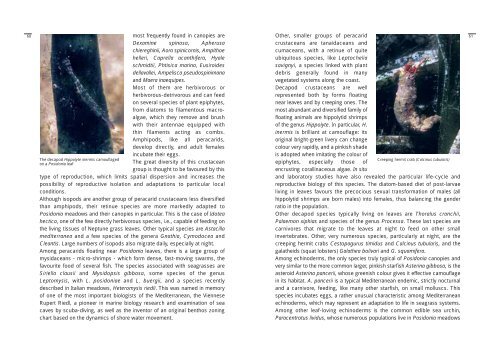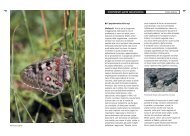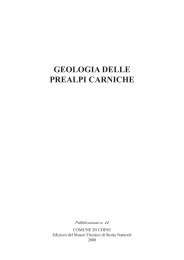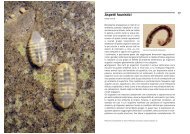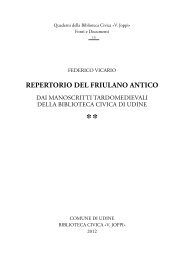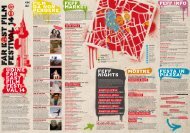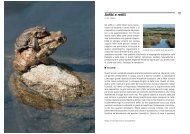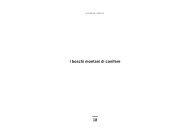Fauna: invertebrates - Udine Cultura
Fauna: invertebrates - Udine Cultura
Fauna: invertebrates - Udine Cultura
You also want an ePaper? Increase the reach of your titles
YUMPU automatically turns print PDFs into web optimized ePapers that Google loves.
60<br />
The decapod Hippolyte inermis camouflaged<br />
on a Posidonia leaf<br />
most frequently found in canopies are<br />
Dexamine spinosa, Apherusa<br />
chiereghinii, Aora spinicornis, Ampithoe<br />
helleri, Caprella acanthifera, Hyale<br />
schmidtii, Phtisica marina, Eusiroides<br />
dellavallei, Ampelisca pseudospinimana<br />
and Maera inaequipes.<br />
Most of them are herbivorous or<br />
herbivorous-detrivorous and can feed<br />
on several species of plant epiphytes,<br />
from diatoms to filamentous macroalgae,<br />
which they remove and brush<br />
with their antennae equipped with<br />
thin filaments acting as combs.<br />
Amphipods, like all peracarids,<br />
develop directly, and adult females<br />
incubate their eggs.<br />
The great diversity of this crustacean<br />
group is thought to be favoured by this<br />
type of reproduction, which limits spatial dispersion and increases the<br />
possibility of reproductive isolation and adaptations to particular local<br />
conditions.<br />
Although isopods are another group of peracarid crustaceans less diversified<br />
than amphipods, their retinue species are more markedly adapted to<br />
Posidonia meadows and their canopies in particular. This is the case of Idotea<br />
hectica, one of the few directly herbivorous species, i.e., capable of feeding on<br />
the living tissues of Neptune grass leaves. Other typical species are Astacilla<br />
mediterranea and a few species of the genera Gnathia, Cymodocea and<br />
Cleantis. Large numbers of isopods also migrate daily, especially at night.<br />
Among peracarids floating near Posidonia leaves, there is a large group of<br />
mysidaceans - micro-shrimps - which form dense, fast-moving swarms, the<br />
favourite food of several fish. The species associated with seagrasses are<br />
Siriella clausii and Mysidopsis gibbosa, some species of the genus<br />
Leptomysis, with L. posidoniae and L. buergii, and a species recently<br />
described in Italian meadows, Heteromysis riedli. This was named in memory<br />
of one of the most important biologists of the Mediterranean, the Viennese<br />
Rupert Riedl, a pioneer in marine biology research and examination of sea<br />
caves by scuba-diving, as well as the inventor of an original benthos zoning<br />
chart based on the dynamics of shore water movement.<br />
Other, smaller groups of peracarid<br />
crustaceans are tanaidaceans and<br />
cumaceans, with a retinue of quite<br />
ubiquitous species, like Leptochelia<br />
savignyi, a species linked with plant<br />
debris generally found in many<br />
vegetated systems along the coast.<br />
Decapod crustaceans are well<br />
represented both by forms floating<br />
near leaves and by creeping ones. The<br />
most abundant and diversified family of<br />
floating animals are hippolytid shrimps<br />
of the genus Hippolyte. In particular, H.<br />
inermis is brilliant at camouflage: its<br />
original bright-green livery can change<br />
colour very rapidly, and a pinkish shade<br />
is adopted when imitating the colour of<br />
Creeping hermit crab (Calcinus tubularis)<br />
epiphytes, especially those of<br />
encrusting corallinaceous algae. In situ<br />
and laboratory studies have also revealed the particular life-cycle and<br />
reproductive biology of this species. The diatom-based diet of post-larvae<br />
living in leaves favours the precocious sexual transformation of males (all<br />
hippolytid shrimps are born males) into females, thus balancing the gender<br />
ratio in the population.<br />
Other decapod species typically living on leaves are Thoralus cranchii,<br />
Palaemon xiphias and species of the genus Processa. These last species are<br />
carnivores that migrate to the leaves at night to feed on other small<br />
<strong>invertebrates</strong>. Other, very numerous species, particularly at night, are the<br />
creeping hermit crabs Cestopagurus timidus and Calcinus tubularis, and the<br />
galatheids (squat lobsters) Galathea bolivari and G. squamifera.<br />
Among echinoderms, the only species truly typical of Posidonia canopies and<br />
very similar to the more common larger, pinkish starfish Asterina gibbosa, is the<br />
asteroid Asterina pancerii, whose greenish colour gives it effective camouflage<br />
in its habitat. A. pancerii is a typical Mediterranean endemic, strictly nocturnal<br />
and a carnivore, feeding, like many other starfish, on small molluscs. This<br />
species incubates eggs, a rather unusual characteristic among Mediterranean<br />
echinoderms, which may represent an adaptation to life in seagrass systems.<br />
Among other leaf-loving echinoderms is the common edible sea urchin,<br />
Paracentrotus lividus, whose numerous populations live in Posidonia meadows<br />
61


